Feynman and Gell-Mann
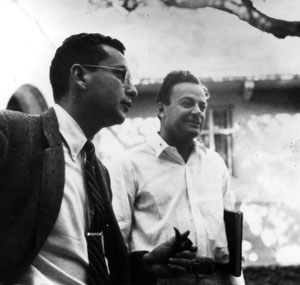
|
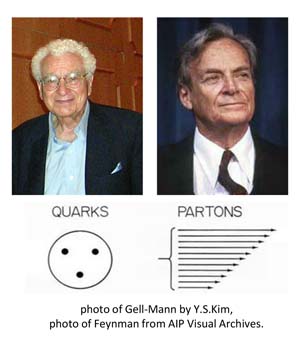
|
Undoubtedly they had their differences. Let us look at one of them. According to Gell-Mann, hadrons are bound states of quarks. This is how he gained his "understanding" of hadronic spectra. Feynman looked at hadrons moving with a velocity close to the speed of light, and came up with his parton model. Thus, Gell-Mann and Feynman ended up with two different pictures of hadrons.
However, are these two different views are really different? In our world of Einstein, we firmly believe that they are two different manifestations of one Lorentz-covariant entity. The question then is whether we should religiously believe in this without raising the question of how. If we do, Einstein would become angry and would punish us.
The only way to make Einstein happy is to resolve this quark-parton puzzle as Einstein derived the same energy-momentum relation applicable to both massive and massless particles.
| ||||
| ||||
| ||||
|
It is not an easy problem. We have to formulate framework for Lorentz-covariant bound states. I do quantum mechanics of a hydrogen atom in my Lorentz frame where the atom is at rest. If you are on a bicycle, how would my quantum mechanics appear to you? In order to obtain discrete energy spectra, I have to impose boundary conditions on the wave functions. Then, how would my boundary condition appear to you? My space-like variables are mixed with the time-like variable.
Dirac and Feynman
- P. A. M. Dirac, Proc. Roy. Soc. (London) A114, 243 (1927).
- P. A. M. Dirac, Proc. Roy. Soc. (London) A183 , 284 (1945).
- P. A. M. Dirac, Rev. Mod. Phys. 21 , 392 (1949).
- P. A. M. Dirac, J. Math. Phys. 4 , 901 (1963).
- R. P. Feynman,
Phys. Rev. Lett. 23, 1415 (1969);
R. P. Feynman, The Behavior of Hadron Collisions at Extreme Energies , in High Energy Collisions, Proceedings of the Third Topical Conference on High Energy Collisions of Hadrons, Stony Brook, New York, edited by C. N. Yang et al., Pages 237-249 (Gordon and Breach, New York, 1969). - R. P. Feynman, M. Kislinger, and F. Ravndal, Phys. Rev. D 3, 2706 (1971).
- R. P. Feynman, Statistical Mechanics (Benjamin/Cummings, Reading, MA, 1972).
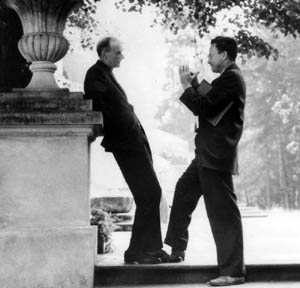
|
Who was there in 2013? |
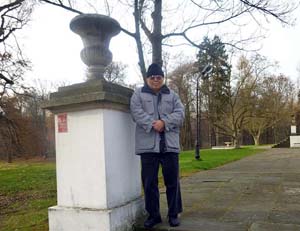
|
In 1962, I was a first-year assistant professor at the University of Maryland when Dirac came, and I had to provide convenience to him. While I was alone with him, I asked him what the most important problem is in American physics and what I should study. I asked this question because I did not believe in what most of my colleagues were excited about at that time: bootstraps, N/D methods, strip approximations, just about one new word every week.
Dirac's answer was that there are many things people do not understand about Lorentz invariance and Lorentz covariance. He was not talking about Chew or Mandelstam (headline makers at that time). I have been wondering about who was the person he had in mind. Recently, after studying Dirac's papers and Feynman's papers, I came to the conclusion that Dirac was talking about Feynman, especially in view of the fact that he was talking to me two months after he talked with Feynman as shown in this photo.
Paul A. M. Dirac is known to us for his Dirac equation. Richard P. Feynman is known to us for Feynman diagrams. In fact, these two great physicists were interested in deeper foundational problems. Both Dirac and Feynman were intensely interested in combining quantum mechanics with special relativity.
However, their approaches to physics were quite different. Dirac was interested in mathematical formulas with esthetic appeal. On the other hand, Feynman was interested in observing what is happening in the world and fill in mathematical formulas as needed.
Feynman's parton picture is one of his brilliant observations. Yet, this is valid in the infinite-momentum system and lacks Lorentz covariance. Thus, it is fun to look into the possibility of making it covariant by filling in mathematical formulas from Dirac's papers.
One way to do is to observe that both Dirac and Feynman were quite fond of harmonic oscillators because they satisfy Dirac's need for mathematical beauty, and also Feynman's need to fill in mathematical formulas readily available.
Dirac never liked the present form of quantum mechanics based on probabilistic interpretation. On the other hand, he held the view that,if we accept this interpretation, this form of quantum mechanics should be consistent with Lorentz covariance. Dirac published the following papers on this subject.
In his effort to combine quantum mechanics with relativity, Feynman first considered waves propagating in the Lorentz-covariant world, resulting in Feynman diagrams. How about standing waves? Feynman considered harmonic oscillators. Feynman would have liked to give a covariant description his parton picture, but left this problem as a homework problem for younger physicists. He wrote the following provocative papers on this subject.
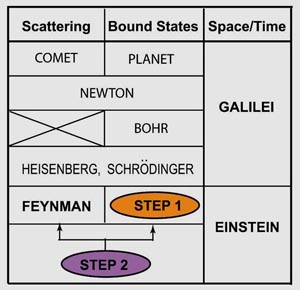
|
It is gratifying to note that both Dirac and Feynman used harmonic oscillators to develop their ideas. Thus, it is very easy to close the gap between the two different approaches. If we complete the job, we add "step 1" in the history table you are seeing now. The table caption can be as long as a short article. Click here for the caption.
If you wish to construct a canal, the only method is to connect the existing lakes. Einstein constructed his special theory of relativity by connecting two big lakes in physics, namely mechanics and electromagnetism. Heisenberg came up with his uncertainty principle in order to connect particle aspects and wave aspects of matter. You do not have to be Einstein or Heisenberg. There many smaller problems in physics we can handle.
Emanuel Kant formulated this aspect of human life into a philosophy. Einstein was heavily influenced by this Kantian way of thinking in his early years. I constructed a webpage about this subject, which became my most frequently visited page. You may click here for my most popular webpage.
This webpage is based in part on my earlier article on Dirac and Feynman. I would like to thank Professor Lev Okun for raising some critical questions. This webpage is also based on my reply to him. It is a pleasure to invite you to my Okun page. I thank also Professor Iwo Bialynicki-Birula for telling me a background story about the Dirac-Feynman photo shown on this webpage. Professor Iwo Bialynicki-Birula also had a photo with Feynman by the same Polish photographer in 1962. Click here for the photo. Forty four years later, I had the pleasure of posing with Prof. Bialynicki-Birula in Vaxjo (Sweden 2006).
Y.S.Kim (July 30, 2007)
- The 1959 photo of Feynman and Gell-Mann is licensed from the Caltech
Photo Archives.
- The photo of Dirac and Feynman is also licensed from the Caltech Photo Archive. This photo was taken by Marek Holzman during the International Conference on Relativitic Theory of Gravitation in Warsaw (Poland) on July 25-31 1962, organized by Leopold Infeld.
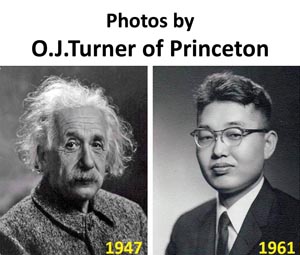
| |
|